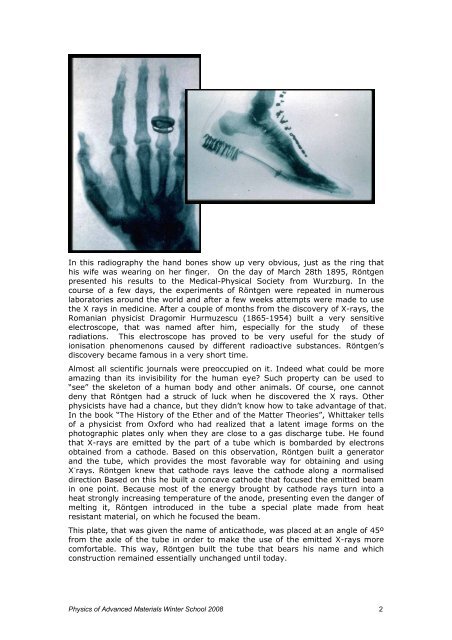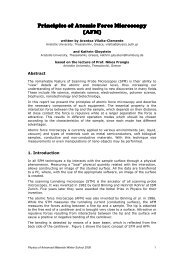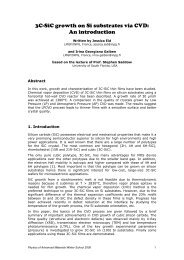The Röntgen Radiation and its application in studies of ... - Mansic
The Röntgen Radiation and its application in studies of ... - Mansic
The Röntgen Radiation and its application in studies of ... - Mansic
Create successful ePaper yourself
Turn your PDF publications into a flip-book with our unique Google optimized e-Paper software.
In this radiography the h<strong>and</strong> bones show up very obvious, just as the r<strong>in</strong>g that<br />
his wife was wear<strong>in</strong>g on her f<strong>in</strong>ger. On the day <strong>of</strong> March 28th 1895, <strong>Röntgen</strong><br />
presented his results to the Medical-Physical Society from Wurzburg. In the<br />
course <strong>of</strong> a few days, the experiments <strong>of</strong> <strong>Röntgen</strong> were repeated <strong>in</strong> numerous<br />
laboratories around the world <strong>and</strong> after a few weeks attempts were made to use<br />
the X rays <strong>in</strong> medic<strong>in</strong>e. After a couple <strong>of</strong> months from the discovery <strong>of</strong> X-rays, the<br />
Romanian physicist Dragomir Hurmuzescu (1865-1954) built a very sensitive<br />
electroscope, that was named after him, especially for the study <strong>of</strong> these<br />
radiations. This electroscope has proved to be very useful for the study <strong>of</strong><br />
ionisation phenomenons caused by different radioactive substances. <strong>Röntgen</strong>’s<br />
discovery became famous <strong>in</strong> a very short time.<br />
Almost all scientific journals were preoccupied on it. Indeed what could be more<br />
amaz<strong>in</strong>g than <strong>its</strong> <strong>in</strong>visibility for the human eye? Such property can be used to<br />
“see” the skeleton <strong>of</strong> a human body <strong>and</strong> other animals. Of course, one cannot<br />
deny that <strong>Röntgen</strong> had a struck <strong>of</strong> luck when he discovered the X rays. Other<br />
physicists have had a chance, but they didn’t know how to take advantage <strong>of</strong> that.<br />
In the book “<strong>The</strong> History <strong>of</strong> the Ether <strong>and</strong> <strong>of</strong> the Matter <strong>The</strong>ories”, Whittaker tells<br />
<strong>of</strong> a physicist from Oxford who had realized that a latent image forms on the<br />
photographic plates only when they are close to a gas discharge tube. He found<br />
that X-rays are emitted by the part <strong>of</strong> a tube which is bombarded by electrons<br />
obta<strong>in</strong>ed from a cathode. Based on this observation, <strong>Röntgen</strong> built a generator<br />
<strong>and</strong> the tube, which provides the most favorable way for obta<strong>in</strong><strong>in</strong>g <strong>and</strong> us<strong>in</strong>g<br />
X - rays. <strong>Röntgen</strong> knew that cathode rays leave the cathode along a normalised<br />
direction Based on this he built a concave cathode that focused the emitted beam<br />
<strong>in</strong> one po<strong>in</strong>t. Because most <strong>of</strong> the energy brought by cathode rays turn <strong>in</strong>to a<br />
heat strongly <strong>in</strong>creas<strong>in</strong>g temperature <strong>of</strong> the anode, present<strong>in</strong>g even the danger <strong>of</strong><br />
melt<strong>in</strong>g it, <strong>Röntgen</strong> <strong>in</strong>troduced <strong>in</strong> the tube a special plate made from heat<br />
resistant material, on which he focused the beam.<br />
This plate, that was given the name <strong>of</strong> anticathode, was placed at an angle <strong>of</strong> 45º<br />
from the axle <strong>of</strong> the tube <strong>in</strong> order to make the use <strong>of</strong> the emitted X-rays more<br />
comfortable. This way, <strong>Röntgen</strong> built the tube that bears his name <strong>and</strong> which<br />
construction rema<strong>in</strong>ed essentially unchanged until today.<br />
Physics <strong>of</strong> Advanced Materials W<strong>in</strong>ter School 2008 2




